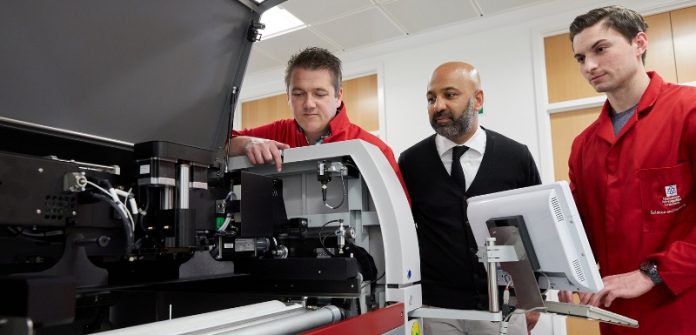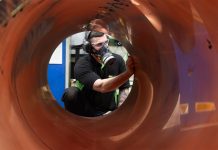Creating a renewable and sustainable source of energy from hydrogen that is also affordable could be unlocked with Manchester Metropolitan University’s innovative use of screen-printed nanotechnology.
Researchers will test a way to provide a green source of power that could be harnessed by remote communities who are off the electricity grid and reliant on imported diesel and petrol for generators.
The idea is to be able to print large volumes of inexpensive electrodes for use in electrolysers, a device that breaks water into its component oxygen and hydrogen. The hydrogen can then be stored or transported and fed when needed into fuel cells to create electricity on demand as a more dependable and efficient source of fuel than solar, wind, wave and tidal energy.
It builds on previous University proof-of-concept work into finding an alternate way of manufacturing electrodes that are traditionally reliant on components made out of expensive platinum and iridium, metal elements whose cost prohibits cheap reproduction.
Under the project, the Manchester Metropolitan University team – led by Craig Banks, Professor in Electrochemical and Nanotechnology – plan to screen print a succession of electrodes with the necessary graphene-like nanotechnology embedded in a fluid carbon-based printer ink.
The screen-printing technique, which will take place at the University’s new £4 million Manchester Fuel Cell Innovation Centre, would enable the electrodes to be printed in novel shapes and styles, as well as allowing them to be mass produced for industrial applications.
Manchester Metropolitan University’s prototype electrodes will be fitted into a stack of water electrolysis cells that will then be ‘harsh weather tested’ on Scotland’s Orkney archipelago.
Research Associate Dr Samuel Rowley-Neale said: “The electricity generated by wind, wave, tidal and solar power is often ill correlated to consumer demand and typically has to be fed into the National Grid where it is used instantly or must be expensively captured somehow, such as in a battery – which has issues with degradation – or else the turbines have to be shut off to ensure the generated electricity does not overload the electricity grid.
“That means it is difficult to balance the electricity being generated to the level of demand.
“In contrast, an electrolyser creates hydrogen that can be easily stored and physically transported as a gas with no deterioration, and then later fed into a fuel cell for conversion to power when needed.
“And unlike the burning of fossil fuels, the only by-product is oxygen and some water that are harmless to the environment.”
Manchester Metropolitan University won a £100,000 grant from Engineering and Physical Sciences Research Council to pursue the research, one of only two successful projects in a funding stream reserved for developing materials for hydrogen production.
The electrolyser cell casings will be 3D printed at the University’s new digital training centre, PrintCity, that opened this spring as a hub for innovation, education and collaboration.
With Prof Banks as the academic lead, the state-of-the-art PrintCity laboratory provides advice, training, teaching, consultancy and production services in the area of advanced additive and subtractive manufacturing.
Dr Rowley-Neale said: “We are at the forefront of 2D nanotechnology printing, building on previous research conducted here and elsewhere.
“We are taking the proof of concept one step further and making actual products with it.”
The researchers are collaborating with the European Marine Energy Centre, the world-leading test and development centre for wave and tidal devices based on Orkney, Scotland, to research the capabilities and performance of the screen-printed electrolysers, the cells and the fuel cells.
There will be six months of electrode development at the University followed by installation of the electrolyser stack in Scotland and connection to a renewable energy system and then a further six months’ testing.







